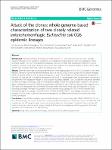Attack of the clones: whole genome-based characterization of two closely related enterohemorrhagic Escherichia coli O26 epidemic lineages
Karnisova, Lucia
Marejkova, Monika
Hrbackova, Hana
Mellmann, Alexander
Karch, Helge
Fruth, Angelika
Drevinek, Pavel
Blahova, Kveta
Bielaszewska, Martina
Nunvar, Jaroslav
Background:
Enterohemorrhagic Escherichia coli (EHEC) O26:H11/H−, the most common non-O157 serotype causing hemolytic uremic syndrome worldwide, are evolutionarily highly dynamic with new pathogenic clones emerging rapidly. Here, we investigated the population structure of EHEC O26 isolated from patients in several European countries using whole genome sequencing, with emphasis on a detailed analysis of strains of the highly virulent new European clone (nEC) which has spread since 1990s.
Results:
Genome-wide single nucleotide polymorphism (SNP)-based analysis of 32 EHEC O26 isolated in the Czech Republic, Germany, Austria and Italy demonstrated a split of the nEC (ST29C2 clonal group) into two distinct lineages, which we termed, based on their temporal emergence, as “early” nEC and “late” nEC. The evolutionary divergence of the early nEC and late nEC is marked by the presence of 59 and 70 lineage-specific SNPs (synapomorphic mutations) in the genomes of the respective lineages. In silico analyses of publicly available E. coli O26 genomic sequences identified the late nEC lineage worldwide. Using a PCR designed to target the late nEC synapomorphic mutation in the sen/ent gene, we identified the early nEC decline accompanied by the late nEC rise in Germany and the Czech Republic since 2004 and 2013, respectively. Most of the late nEC strains harbor one of two major types of Shiga toxin 2a (Stx2a)-encoding prophages. The type I stx2a-phage is virtually identical to stx2a-phage of EHEC O104:H4 outbreak strain, whereas the type II stx2a-phage is a hybrid of EHEC O104:H4 and EHEC O157:H7 stx2a-phages and carries a novel mutation in Stx2a. Strains harboring these two phage types do not differ by the amounts and biological activities of Stx2a produced.
Conclusions:
Using SNP-level analyses, we provide the evidence of the evolutionary split of EHEC O26:H11/H− nEC into two distinct lineages, and a recent replacement of the early nEC by the late nEC in Germany and the Czech Republic. PCR targeting the late nEC synapomorphic mutation in ent/sen enables the discrimination of early nEC strains and late nEC strains in clinical and environmental samples, thereby facilitating further investigations of their geographic distribution, prevalence, clinical significance and epidemiology.
Dateien zu dieser Publikation

